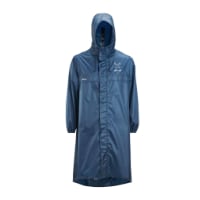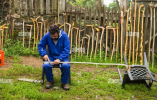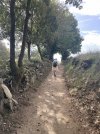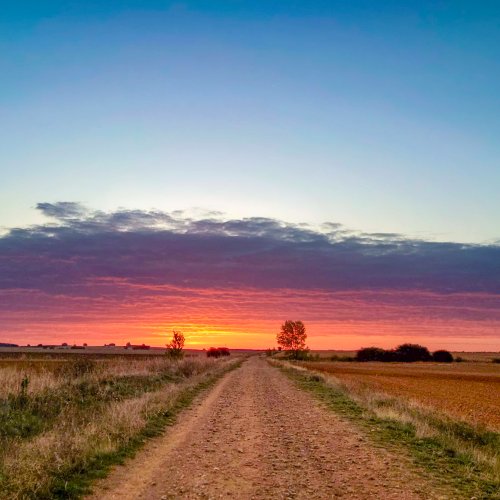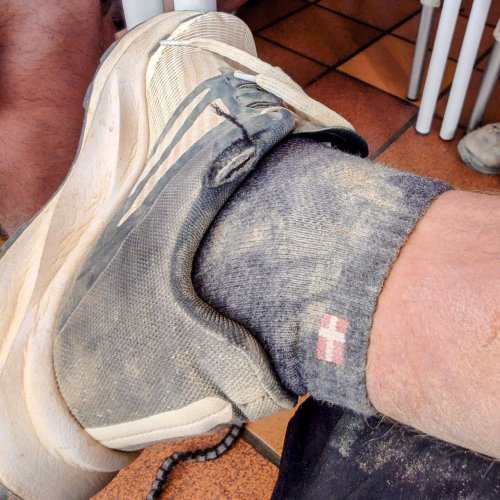- Time of past OR future Camino
- 23:Valença Var Espiritual Apr; Norte Cudillero Oct
-
For 2024 Pilgrims: €50,- donation = 1 year with no ads on the forum + 90% off any 2024 Guide. More here.
(Discount code sent to you by Private Message after your donation)
Search 69,459 Camino Questions
You are using an out of date browser. It may not display this or other websites correctly.
You should upgrade or use an alternative browser.
You should upgrade or use an alternative browser.
Pole Poll
- Thread starter El Cascayal
- Start date
€2,-/day will present your project to thousands of visitors each day. All interested in the Camino de Santiago.
- Time of past OR future Camino
- 1989, 2016, 2018, 2023, 2024...
I have the poles so that when I am standing with them and they are vertical, my elbows are at a 90 degree angle, more or less. But when I am walking on a flat plain, they tend to be angled behind me, which would mean that my elbows don't reach that 90 degrees. On a flat plain, I tend to use them to help propel me forward. If I pushed straight down vertically on them, they wouldn't do that. It is different when I am going downhill and tend to plant them in front of me to help bear my weight rather than to propel me down the hill. And it is probably different if I am using them for balance on tricky ground.
- Time of past OR future Camino
- Us:Camino Frances, 2015 Me:Catalan/Aragonese, 2019
I'm disqualified from the poll because I only use one, if any at all, and most of the time my elbow is at 180⁰. That is to say my arm is straight down with my fingers cupped and the pole balanced horizontally with the grip in front. It makes bears trying to sneak up on me keep their distance.
Last edited:
A selection of Camino Jewellery
- Time of past OR future Camino
- Most years since 2012
All I can say is that I admire your thread title and applaud your courage for starting a poll! 

- Time of past OR future Camino
- Past: a few
Last: Sanabres
Next: St Olav's Way
Neither! For roughly level ground I will have the length set so that my forearm slopes down slightly from the elbow. I walk often enough in the rain, and this ensures that when I am wearing a rain jacket, rain does not collect in the sleeve and pool in the elbow of the jacket. Of course, if I were truly well disciplined, I could always shake the water out before lifting my arm for some reason, but I'm not. You can imagine the thrill of remembering too late, about the time a stream of water is running down inside the jacket.
From that initial position, I will adjust the length when going up or down steeper slopes. I find this more important going downhill, where I will extend the pole length by as much as 20 cm for really steep slopes. My aim is to ensure that I am still walking upright, and not leaning forward to plant the pole tips well ahead of my feet going downhill. It is possible to maintain a normal or slightly faster pace going downhill doing this while using the poles to maintain balance and stability. If the track surface is even and doesn't have too many large rocks or other obstacles, it is possible to gain considerable speed on steeper slopes doing this while still maintaining good control.
Less often, I will shorten the poles going uphill, but not as regularly as I would going downhill. On less steep slopes, I find it just as easy to lift my hands up a little and plant the pole tip a little closer to the heel of my leading foot than the toe. Only if the slope gets steeper might I consider shortening the poles.
Over the years on the camino, I can only recall a couple of times where I have found it has been necessary to shorten my poles, but I have regularly lengthened them. What I don't ever recall doing on the camino in Spain and Portugal is differentially lengthening or shortening the pole on one side or the other to account for steeper side slopes. I have done that just once on a pilgrimage walk, in Norway. It was on a short section of the Gudbrandsdalsleden shortly after Kongsvoll. Those who have walked there might recall the quite savage sideslope for the first few kilometres where the walking track is further up the valley wall to avoid the E6.
From that initial position, I will adjust the length when going up or down steeper slopes. I find this more important going downhill, where I will extend the pole length by as much as 20 cm for really steep slopes. My aim is to ensure that I am still walking upright, and not leaning forward to plant the pole tips well ahead of my feet going downhill. It is possible to maintain a normal or slightly faster pace going downhill doing this while using the poles to maintain balance and stability. If the track surface is even and doesn't have too many large rocks or other obstacles, it is possible to gain considerable speed on steeper slopes doing this while still maintaining good control.
Less often, I will shorten the poles going uphill, but not as regularly as I would going downhill. On less steep slopes, I find it just as easy to lift my hands up a little and plant the pole tip a little closer to the heel of my leading foot than the toe. Only if the slope gets steeper might I consider shortening the poles.
Over the years on the camino, I can only recall a couple of times where I have found it has been necessary to shorten my poles, but I have regularly lengthened them. What I don't ever recall doing on the camino in Spain and Portugal is differentially lengthening or shortening the pole on one side or the other to account for steeper side slopes. I have done that just once on a pilgrimage walk, in Norway. It was on a short section of the Gudbrandsdalsleden shortly after Kongsvoll. Those who have walked there might recall the quite savage sideslope for the first few kilometres where the walking track is further up the valley wall to avoid the E6.
Last edited:
St James' Way - Self-guided 4-7 day Walking Packages, Reading to Southampton, 110 kms
- Time of past OR future Camino
- 23:Valença Var Espiritual Apr; Norte Cudillero Oct
I got the courage from one of your recent poll responses about where it is we all come from or something like that.All I can say is that I admire your thread title and applaud your courage for starting a poll!

Kiwi-family
{Rachael, the Mama of the family}
- Time of past OR future Camino
- walking every day for the rest of my life
And here I was thinking I would be able to give a vote to Pacerpoles!!
 www.pacerpole.com
www.pacerpole.com
Basic Walking
Trekking poles, Walking poles, Pacerpoles apply biomechanics to whole body movement
- Time of past OR future Camino
- 23:Valença Var Espiritual Apr; Norte Cudillero Oct
Polls are unfair.And here I was thinking I would be able to give a vote to Pacerpoles!!
Basic Walking
Trekking poles, Walking poles, Pacerpoles apply biomechanics to whole body movementwww.pacerpole.com
€2,-/day will present your project to thousands of visitors each day. All interested in the Camino de Santiago.
- Time of past OR future Camino
- 23:Valença Var Espiritual Apr; Norte Cudillero Oct
I guess it’s more about the rhythm. Lately, I see so many people walking with poles as if they were skiing. Never seen anyone go airborne, though.Neither! For roughly level ground I will have the length set so that my forearm slopes down slightly from the elbow. I walk often enough in the rain, and this ensures that when I am wearing a rain jacket, rain does not collect in the sleeve and pool in the elbow of the jacket. Of course, if I were truly well disciplined, I could always shake the water out before lifting my arm for some reason, but I'm not. You can imagine the thrill of remembering too late, about the time a stream of water is running down inside the jacket.
From that initial position, I will adjust the length when going up or down steeper slopes. I find this more important going downhill, where I will extend the pole length my as much as 20 cm for really steep slopes. My aim is to ensure that I am still walking upright, and not leaning forward to plant the pole tips well ahead of my feet going downhill. It is possible to maintain a normal or slightly faster pace going downhill doing this while using the poles to maintain balance and stability. If the track surface is even and doesn't have too many large rocks or other obstacles, it is possible to gain considerable speed on steeper slopes doing this while still maintaining good control.
Less often, I will shorten the poles going uphill, but not as regularly as I would going downhill. On less steep slopes, I find it just as easy to lift my hands up a little and plant the pole tip a little closer to the heel of my leading foot than the toe. Only if the slope gets steeper might I consider shortening the poles.
Over the years on the camino, I can only recall a couple of times where I have found it has been necessary to shorten my poles, but I have regularly lengthened them. What I don't ever recall doing on the camino in Spain and Portugal is differentially lengthening or shortening the pole on one side or the other to account for steeper side slopes. I have done that just once on a pilgrimage walk, in Norway. It was on a short section of the Gudbrandsdalsleden shortly after Kongsvoll. Those who have walked there might recall the quite savage sideslope for the first few kilometres where the walking track is further up the valley wall to avoid the E6.
- Time of past OR future Camino
- Most years since 2012
Do you mean that they seem to have the poles planted somewhat behind their feet? It is true that if you plant them just behind the forward heel, as you move forward, the pole will generally be behind you (assuming level ground). I think this is more a function of where you place the pole, than of the angle of your elbow. At the time of planting, your elbow will be about 90 degrees. As you move forward, pushing, that angle will open up a little. (I think of it as opening to 135 degrees, rather than closing to 45, but that would be a different debate!)I see so many people walking with poles as if they were skiing.
This is just my impression without careful analysis, and I fully expect to be corrected. However, I am comfortable with my technique and think it starts with a 90 degree elbow angle, with a bit of relaxation as I stride forward.
No, but you have surely seen (or done) some face plants.Never seen anyone go airborne, though.
- Time of past OR future Camino
- 23:Valença Var Espiritual Apr; Norte Cudillero Oct
No they walk with the poles as if they were skiing. As in this cartoonDo you mean that they seem to have the poles planted somewhat behind their feet?
Very light, comfortable and compressible poncho. Specially designed for protection against water for any activity.
Our Atmospheric H30 poncho offers lightness and waterproofness. Easily compressible and made with our Waterproof fabric, its heat-sealed interior seams guarantee its waterproofness. Includes carrying bag.
€60,-
Our Atmospheric H30 poncho offers lightness and waterproofness. Easily compressible and made with our Waterproof fabric, its heat-sealed interior seams guarantee its waterproofness. Includes carrying bag.
€60,-
- Time of past OR future Camino
- CF: 2001, 02, 04, 14. Ourense to Santiago 2019.
I guess it’s more about the rhythm. Lately, I see so many people walking with poles as if they were skiing. Never seen anyone go airborne, though.
The moguls will be in place somewhere between O’Cebreiro and Molinaseca or Saint Jean Pied de Port to Roncesvalles.
That should facilitate flight.
- Time of past OR future Camino
- Frances 2019
Portugues 2022
VDLP 2023
I am a one poler everywhere except the Camino. There is not enough room on the narrow or sometimes non existent tracks through the bush I walk in to use two poles.
- Time of past OR future Camino
- Most years since 2012
That looks like the elbows are still at 90 degrees, though.No they walk with the poles as if they were skiing. As in this cartoonbut flat.
Last edited:
St James' Way - Self-guided 4-7 day Walking Packages, Reading to Southampton, 110 kms
- Time of past OR future Camino
- 23:Valença Var Espiritual Apr; Norte Cudillero Oct
If you super-impose a protractor it looks about 45 degrees to me.Tgat looks like the elbiws are still at 90 degrees, though.
Attachments
- Time of past OR future Camino
- Most years since 2012
When I get out my magnifying glass, I see that I was wrong. But the skier's arms look quite straight to me, which I would call 180 degrees. Maybe they don't have any elbows.
(Aren't polls fun!?


 )
)
(Aren't polls fun!?
duncanwhyte
Active Member
- Time of past OR future Camino
- Vdlp
It might be the handles. Some are moulded to fit the grasp and offer an angle approx. 45 to the vertical of the pole. They feel easier on the wrists.
€2,-/day will present your project to thousands of visitors each day. All interested in the Camino de Santiago.
- Time of past OR future Camino
- 23:Valença Var Espiritual Apr; Norte Cudillero Oct
Here’s a video from this morning in my neighborhood.
View attachment IMG_4877.mov
View attachment IMG_4877.mov
duncanwhyte
Active Member
- Time of past OR future Camino
- Vdlp
Then again there's probably untold skiers who pitch their poles at 90 degrees. But I didn't see any this morning as I made my way to work.
- Time of past OR future Camino
- 1989, 2016, 2018, 2023, 2024...
When I use the poles they are not parallel to the ground, as in your illustration, but pushing on it. Parallel to the ground seems pretty useless, although I have witnessed a number of walkers using then that way, generally carried in one handNo they walk with the poles as if they were skiing. As in this cartoonbut flat.
Join our full-service guided tour and let us convert you into a Pampered Pilgrim!
MichelleElynHogan
Veteran Member
Trouble at the airport TSA with your walking pole? Wear dark sunglasses and paint your walking pole white…and put a tennis ball on the end.
- Time of past OR future Camino
- 23:Valença Var Espiritual Apr; Norte Cudillero Oct
Oh please, MichelleElyn, you had to go there. I just bought collapsible poles to see if I can get away with it the way some Senior and perhaps moderator Peregrinas do. You know who you are, youTrouble at the airport TSA with your walking pole? Wear dark sunglasses and paint your walking pole white…and put a tennis ball on the end.
walkingstu
Member
- Time of past OR future Camino
- Camino SJPP to SDC 2007 Frances
Camino Aragon Pau Fr. to Pamplona 2010
Camino Burgos to SDC 2012
Camino Porto to SDC 2015
Camino VDLP Seville to SDC March 2016
Not unfair. They are very democratic, ask any dog.Polls are unfair.
Down bag (90/10 duvet) of 700 fills with 180 g (6.34 ounces) of filling. Mummy-shaped structure, ideal when you are looking for lightness with great heating performance.
€149,-
€149,-
- Time of past OR future Camino
- CF 2012, others, hospitalero, resumed VdlP 2022
Used to walk with one pole, saw lots of folk waving two poles around like wands, then saw this excellent YouTube clip about how to use two poles
and am now totally converted to two, carbon fibre poles
- Time of past OR future Camino
- Recent:Norte/Muxia- Spring '23
MadridWay- Fall '23
Especially when they are about poles.When I get out my magnifying glass, I see that I was wrong. But the skier's arms look quite straight to me, which I would call 180 degrees. Maybe they don't have any elbows.
(Aren't polls fun!?


)
Scott Fraser
Active Member
- Time of past OR future Camino
- Frances 17&18; Podiensis 19, VdlP exSalamanca 22
Nice video. It might help if you did it in SLO-mo. He’s walking very fast.Here’s a video from this morning in my neighborhood.
New Original Camino Gear Designed Especially with The Modern Peregrino In Mind!
- Time of past OR future Camino
- 23:Valença Var Espiritual Apr; Norte Cudillero Oct
Yes, he leaves the whole neighborhood walkers (not counting dog walkers with leashes & not poles) in the dust. Strangely today I had to wait for him, sitting on a bench swatting off mosquitoes, what I would do for the Forum  , he may have stopped to talk to someone. He is an expert at the
, he may have stopped to talk to someone. He is an expert at the  while
while technique.
technique.
- Time of past OR future Camino
- Recent:Norte/Muxia- Spring '23
MadridWay- Fall '23
Join our full-service guided tour of the Basque Country and let us pamper you!
joecollins
Member
- Time of past OR future Camino
- April 2024
Is this one of those things that regardless how I use them (or if I do) there will be people quietly judging me and then posting on here about the ignorance of people doing it wrong?
- Time of past OR future Camino
- Francés, Norte, Salvador, Primitivo, Portuguese
ProbablyIs this one of those things that regardless how I use them (or if I do) there will be people quietly judging me and then posting on here about the ignorance of people doing it wrong?
OK...so I used my poles at 90 degrees, as did my wife and son. It was often difficult to walk three abreast with others passing us, and us (rarely) passing others. Being the one taking pictures, I was usually the swing guy- the guy who had to move behind the other two to let people pass.
Anyhow, one of those things that always makes me chuckle is thinking of my teenage son who, just to be humorous and annoy me, would start walking with his poles out 45 degrees to the side ("walking wide") when traffic would be clear for me to move back into place, sometimes complaining that there simply was not space. It would make me laugh every time then...and still does today, four years later!
Anyhow, one of those things that always makes me chuckle is thinking of my teenage son who, just to be humorous and annoy me, would start walking with his poles out 45 degrees to the side ("walking wide") when traffic would be clear for me to move back into place, sometimes complaining that there simply was not space. It would make me laugh every time then...and still does today, four years later!
New Original Camino Gear Designed Especially with The Modern Peregrino In Mind!
- Time of past OR future Camino
- Most years since 2012
He places the pole well behind his forward foot, his elbow starts at close to 90 degrees and then it opens out to 135. It clearly works for him, especially for that sort of even, level urban path.Here’s a video from this morning in my neighborhood
falconbrother
Member
- Time of past OR future Camino
- June - July 2024
I use a walking stick. I do think it's smart to use something, especially on any technical terrain. I fell about a year and 2 months ago and ruptured my quadricep tendon. It required a serious surgery and a long recovery. It was a violent fall in a muddy creek. I did not have poles or a stick to slow the fall. I feel like if I had something I would not have ruptured the tendon. So, find what works for you and use it.
MichelleElynHogan
Veteran Member
Ok, there is one who did not take my idea in the way in which it was intended. When you read it and giggle, let me know by leaving aOh please, MichelleElyn, you had to go there. I just bought collapsible poles to see if I can get away with it the way some Senior and perhaps moderator Peregrinas do. You know who you are, you, you!
3rd Edition. More content, training & pack guides avoid common mistakes, bed bugs etc
Aussiewanderer
New Member
- Time of past OR future Camino
- Camino Frances Camino Portuguese Camino Le Puy
Same !! I think it’s a result of being in a gym using ski machines maybe ? Or some other new evolutionary way for humans to propel themselves along. I still wish people would consider rubber tips to reduce the clack clack which is pure noise pollution starting from Sarria. !!! Or the worst offenders are the ones who just drag them behind as they walk. Or the stabbers. The angry walkers. Either way. It’s great people watchingOn all of my Caminos since 2019, I have used hiking poles. In the past year or two, I have noticed other Peregrinos using poles as if they were skiing.
Discussion will be appreciated.@davebugg et al
Thanks.
- Time of past OR future Camino
- Past: a few
Last: Sanabres
Next: St Olav's Way
It is certainly an interesting video, although the presenter admits that he doesn't use the strap in the conventionally correct manner. I wouldn't be confident that this would work as well as the conventional method were one to start to slip or fall.Used to walk with one pole, saw lots of folk waving two poles around like wands, then saw this excellent YouTube clip about how to use two poles
He also demonstrates a downhill technique where he completely removes the strap, and places his hands over the top of the pole. I find it far easier to lengthen the pole and continue to use the straps as one would normally. This has the advantage of the straps being in the right position to support the walker should there be a slip or fall - something even more likely when descending steeper slopes.
There are now poles like Z-poles and similar designs being marketed where using them going downhill on steeper slopes has become more difficult, but I don't think this is as significant an issue on the Camino. While there might be one or two places on the routes that I have walked where a significant increase in length might be indicated, and the relatively limited adjustment on these poles will stop them being lengthened to a more ideal length, such slopes are less likely than during my normal bush walking. I wouldn't be recommending these designs for serious bush-walking, but they might be fine for most people on the Camino.
- Time of past OR future Camino
- Past: a few
Last: Sanabres
Next: St Olav's Way
What are 'stabbers'?Or the stabbers.
€2,-/day will present your project to thousands of visitors each day. All interested in the Camino de Santiago.
Rita Flower
Veteran Member
- Time of past OR future Camino
- 2024 Via Podiensis
Being a bit lazy this morning I have skipped reading all the comments so will probably be repeating what others have said. But it is a poll / pole …
On the flat use my two poles in the Nordic walking style. I first saw this way of usually poles in 2007. In that way I don’t need to grip the poles tightly and use the muscles of the arms to push myself along. Last Camino I found I could isolate just the muscles in arms and legs that were needed and let the rest of the body be more or less relaxed.
On the up-hill I use a similar style but plant the poles ahead of me and ‘pull’ myself up.
On the down hill I again plant the poles ahead of me but use them for weight bearing as I follow behind.
I think this is pretty much what @David Tallan said - and I am certainly not as diligent as @dougfitz in changing poll lengths for different conditions.
On the flat use my two poles in the Nordic walking style. I first saw this way of usually poles in 2007. In that way I don’t need to grip the poles tightly and use the muscles of the arms to push myself along. Last Camino I found I could isolate just the muscles in arms and legs that were needed and let the rest of the body be more or less relaxed.
On the up-hill I use a similar style but plant the poles ahead of me and ‘pull’ myself up.
On the down hill I again plant the poles ahead of me but use them for weight bearing as I follow behind.
I think this is pretty much what @David Tallan said - and I am certainly not as diligent as @dougfitz in changing poll lengths for different conditions.
Aussiewanderer
New Member
- Time of past OR future Camino
- Camino Frances Camino Portuguese Camino Le Puy
Haven’t you seen stage angry walkers ? They hit the ground with their sticks so hard it’s like they are stabbing the ground beneath them as they go.
Kiwi-d
Active Member
- Time of past OR future Camino
- Camino Frances Sep/Oct 2014
This topic reminded me of a very dear lady I walked with for a while on the Camino. She used her poles like a helicopter coming in for a stormy crash landing. Windmills skipped out of her way. Fortunately I was a faster walker, so could leave her while I still had skin on my shins and wait ahead in the first bar for her to catch up. She was such a sweetheart though I forgave her the demolished hedgerows left in her wake, though it may have taken Spain a little longer to recover.
Down bag (90/10 duvet) of 700 fills with 180 g (6.34 ounces) of filling. Mummy-shaped structure, ideal when you are looking for lightness with great heating performance.
€149,-
€149,-
- Time of past OR future Camino
- Frances (Sep - Oct'14)
Frances (May - Jun'15)
Portugues (May - Jun'16)
Primitivo (2020)
Soooo... they planted their pole, set the edges of their...shoes? and then turned around the walking stick? /sI have noticed other Peregrinos using poles as if they were skiing.
The topic of poles has been an interesting and hotly debated topic for more than a decade that I've been on this forum (as well as water bladder vs water bottles).
What's new today is that the topic has moved beyond poles are useless vs they're great, to "they're great, but are you using them correctly?"
- Time of past OR future Camino
- Most years since 2012
I prefer to do this, as well, on a steep uneven downhill. I just "feel" safer not to be tied up with my poles, although I can imagine there are good arguments both ways. I also like his modification of the way the straps wrap - both for getting out of them more easily and for the sake of my slightly arthritic thumbs.He also demonstrates a downhill technique where he completely removes the strap... I wouldn't be confident that this would work as well as the conventional method were one to start to slip or fall.
bergmannfamily
Active Member
- Time of past OR future Camino
- Camino Frances 2021
Fisterra 2021
I have been a cross country skier for 50 years. I use my poles for walking just like I use them for skiing, so I keep mine fairly tall. On flat ground I drop them ahead of my feet and then push off with them to propel myself forward, using each pole strike for two steps. On an incline they land just beside me and help push me up. I place a new pole for each step. On the downhill I place the pole quite far in front (so I keep them long) in order to prevent acceleration. Like on the uphill, on the downward trail the pole moves for each step.
The wrist straps, if used correctly by entering them from below, hold the pole for you so that you do not grip the pole tightly, but just let it move into your hand as you pass your weight on to it. That does wonders for my arthritic hands that do not, sometimes cannot, hold an object easily, and never can grip tight.
My main reason for starting to use poles for walking was the onset of Parkinson's, and the unsteady balance that comes with it. Now that I can control my descent speed that is a great bonus.
The whole gist of this response is that each person needs to figure out how the poles can help them walk better/more efficient/safer/steadier/faster. If the user accomplishes this goal then the poles have value.
The wrist straps, if used correctly by entering them from below, hold the pole for you so that you do not grip the pole tightly, but just let it move into your hand as you pass your weight on to it. That does wonders for my arthritic hands that do not, sometimes cannot, hold an object easily, and never can grip tight.
My main reason for starting to use poles for walking was the onset of Parkinson's, and the unsteady balance that comes with it. Now that I can control my descent speed that is a great bonus.
The whole gist of this response is that each person needs to figure out how the poles can help them walk better/more efficient/safer/steadier/faster. If the user accomplishes this goal then the poles have value.
The one from Galicia (the round) and the one from Castilla & Leon. Individually numbered and made by the same people that make the ones you see on your walk.
I use my trekking poles at 90, though they do slope some between steps. I really like my Leki poles, German-made and excellent poles. I have helped a number of seniors with balance problems also get poles, and for them I refer them to https://urbanpoling.com/ who have poles they call Activator poles. They are somewhat heavier, and a bit of a different design, but excellent. They have instructions which talk about the difference between the 90 degree angle and the Nordic poling method. Very instructive. I have knee problems and have for the last year used my Leki poles not only for long hikes, but even to walk to work .5 mile away. When I do, some of my knee problems do not occur. I also carry a pack with a laptop to work and using the poles then keeps me in good shape for the next camino I dream of doing!On all of my Caminos since 2019, I have used hiking poles. In the past year or two, I have noticed other Peregrinos using poles as if they were skiing.
Discussion will be appreciated.@davebugg et al
Thanks.
- Time of past OR future Camino
- 23:Valença Var Espiritual Apr; Norte Cudillero Oct
Bonnie, thank you! These videos are so instructive and give me words for what I was attempting to describe. They fully explains both techniques. They name it activator technique (more common apparent use on the Camino, personal observation) & Nordic walking! A real detailed eye opener. Thank you so much!I use my trekking poles at 90, though they do slope some between steps. I really like my Leki poles, German-made and excellent poles. I have helped a number of seniors with balance problems also get poles, and for them I refer them to https://urbanpoling.com/ who have poles they call Activator poles. They are somewhat heavier, and a bit of a different design, but excellent. They have instructions which talk about the difference between the 90 degree angle and the Nordic poling method. Very instructive. I have knee problems and have for the last year used my Leki poles not only for long hikes, but even to walk to work .5 mile away. When I do, some of my knee problems do not occur. I also carry a pack with a laptop to work and using the poles then keeps me in good shape for the next camino I dream of doing!
- Time of past OR future Camino
- 2015-2023 walked all or part of CF 11 times
I have used poles for so long…bought my first pair of Leki poles in1987 in Austria. Have experimented myself…as well as initially observed others using them. What works for me…. I set the poles to accommodate circa a 90 degree elbow angle, never use the straps and adjust my hands depending upon the terrain. On a sustained or steeper downhill, I too may alternate hand positions including placing my hands over the top of the pole, depending upon how steep and long the downhill is. Works for me.He also demonstrates a downhill technique where he completely removes the strap, and places his hands over the top of the pole.
Going uphill, I shift my hands slightly lower as I use my upper body to help drive me up the hill. On flat even terrain, such as paved roads, I may change my technique to increase speed. My hands go back on top of the pole again, as I swing the pole forward. It helps me increase speed so I go an extra step before swinging the other pole. However, my poles are being used more to assist with balance and speed. On uneven paths (or on precarious cliffs not on camino) I place my hands around the grips - there purpose is to support balance.
The focus is on reducing the risk of failure through being well prepared. 2nd ed.
- Time of past OR future Camino
- Francés, Norte, Salvador, Primitivo, Portuguese
After watching the Activator and Nordic technique videos it looks like the difference is using a bent arm vs a straight arm.Bonnie, thank you! These videos are so instructive and give me words for what I was attempting to describe. They fully explains both techniques. They name it activator technique (more common apparent use on the Camino, personal observation) & Nordic walking! A real detailed eye opener. Thank you so much!
- Time of past OR future Camino
- 1989, 2016, 2018, 2023, 2024...
It's not just the angle of the arms; it's also the angle of the poles. The Activator technique plants the poles vertically while the Nordic technique as demonstrated plants the poles at a considerable angle. The result seems to be that the Nordic will propel you a lot more while the Activator will assist a lot more with balance issues.
- Time of past OR future Camino
- 23:Valença Var Espiritual Apr; Norte Cudillero Oct
The next obvious question is how to choose which technique and using a different pole pad for each. Lots to experiment with in the next few weeks.
The 9th edition the Lightfoot Guide will let you complete the journey your way.
- Time of past OR future Camino
- Past: a few
Last: Sanabres
Next: St Olav's Way
No, that's not something that I have seen, or if it is, I'm not recognizing it in your description.Haven’t you seen stage angry walkers ? They hit the ground with their sticks so hard it’s like they are stabbing the ground beneath them as they go.
That said, poles have to be planted with a certain force to get any real benefit, but I don't think of that being like stabbing the ground. That force can be applied smoothly as the pole tip contacts the ground. In contrast, the thing I think I see most is 'fairy tapping', when walkers are putting little or no downward force on their poles. I really don't see the point of doing that.
- Time of past OR future Camino
- Past: a few
Last: Sanabres
Next: St Olav's Way
It appears to me the Activator technique will take more weight off one's lower joints, with almost all the force in the vertical, ie lifting, compared to the Nordic technique demonstrated with a far greater proportion pushing.The result seems to be that the Nordic will propel you a lot more while the Activator will assist a lot more with balance issues.
That should be interesting. I will watch with interest.The next obvious question is how to choose which technique and using a different pole pad for each. Lots to experiment with in the next few weeks.
I haven't seriously tried a 'pure' Nordic technique nor the Activator technique demonstrated. I don't see these as particularly useful techniques for the walking I do. When not on pilgrimage, that is a combination of urban casual walking and bushwalking. When urban walking I am more likely to use a sprung pole with a boot tip, bent arms (see my earlier post) and the poles are angled to give a combination of push and lift. When bushwalking, I tend to use an unsprung pole with a semi-conical shaped pole tip. On the Camino, I have been using an unsprung pole with a boot style tip.
I have tried a knobbly ball style pole tip, but didn't really see the point and found it difficult to put into a pocket when I removed them to get the extra traction from the bare metal tips. I know others who find them useful, but I don't.
The Swix boot style tips I use have a reasonably good life, but I would have a replacement set with me for a longer Camino, but I. also carry a pair or two of the semi-conical tip as spares as well. For a long time, the Black Diamond semi-conical pole tip was the best combination of wear life and cost that I could find where I live, but they have changed their design in the last couple of years, and I no longer feel confident giving an unreserved recommendation about them any more. As an alternative, I have been using a pair of tips from Decathlon that I bought earlier this year.
Last edited:
- Time of past OR future Camino
- I´ve got Camino plans until 2042,
- or till I fall flat on my face, whichever comes first !!
But you can use your poles any which of the suggested ways.
At odd times when I need speed or to stretch or marching, I will adjust to more length on my Lekis and drive myself forward ever so little but this will give me a push for some time.....
I use them instinctively, and nearly always at some speed and, yes sometimes you are flying along...
I have stopped wondering about why some users have them at low height and then daintily placing the on the ground as they go, being of absolutely no use at all...
But bless them, them brought them along.
At odd times when I need speed or to stretch or marching, I will adjust to more length on my Lekis and drive myself forward ever so little but this will give me a push for some time.....
I use them instinctively, and nearly always at some speed and, yes sometimes you are flying along...
I have stopped wondering about why some users have them at low height and then daintily placing the on the ground as they go, being of absolutely no use at all...
But bless them, them brought them along.
Down bag (90/10 duvet) of 700 fills with 180 g (6.34 ounces) of filling. Mummy-shaped structure, ideal when you are looking for lightness with great heating performance.
€149,-
€149,-
- Time of past OR future Camino
- Us:Camino Frances, 2015 Me:Catalan/Aragonese, 2019
That force can be applied smoothly as the pole tip contacts the ground. In contrast, the thing I think I see most is 'fairy tapping', when walkers are putting little or no downward force on their poles. I really don't see the point of doing that.
I have stopped wondering about why some users have them at low height and then daintily placing the on the ground as they go, being of absolutely no use at all...
The dainty fairy tapping type of pole use isn't completely useless as it should help prevent swelling of the hands and keeps the poles at the ready to restore balance or prevent injury in case of collaspe from a twisted ankle or a trick knee going on you. I agree that it doesn't make one walk more efficiently.
- Time of past OR future Camino
- Past: a few
Last: Sanabres
Next: St Olav's Way
This is at best partially true. If you are keeping your forearms level, it will help reduce oedema in the fingers. Whether, when you aren't putting some effort into pressing down on the poles, you will be able to react quickly enough if you trip, twist an ankle, etc is moot. I think it is unlikely, but equally, I am not prepared to test that!!The dainty fairy tapping type of pole use isn't completely useless as it should help prevent swelling of the hands and keeps the poles at the ready to restore balance or prevent injury in case of collaspe from a twisted ankle or a trick knee going on you.
- Time of past OR future Camino
- 23:Valença Var Espiritual Apr; Norte Cudillero Oct
I just ordered boot tips which arrive hopefully on the 3rd. So, I plan to start experimenting on the weekend. Urban walking is different than the various Caminos and I will likely stick to the rounded tips in Spain.
I never use the straps ever since one of the guys here on the Forum posted more than a year ago about face planting and getting tangled in the straps. I use the handles gingerly and avoid the dreaded death grip.
I never use the straps ever since one of the guys here on the Forum posted more than a year ago about face planting and getting tangled in the straps. I use the handles gingerly and avoid the dreaded death grip.
Very light, comfortable and compressible poncho. Specially designed for protection against water for any activity.
Our Atmospheric H30 poncho offers lightness and waterproofness. Easily compressible and made with our Waterproof fabric, its heat-sealed interior seams guarantee its waterproofness. Includes carrying bag.
€60,-
Our Atmospheric H30 poncho offers lightness and waterproofness. Easily compressible and made with our Waterproof fabric, its heat-sealed interior seams guarantee its waterproofness. Includes carrying bag.
€60,-
- Time of past OR future Camino
- Sept Oct - Camino Francis
I have just completed the camino Frances and used my Nordic walking poles the entire way - I used them walking before and know they help me keep a balanced stride, keep my head up and shoulders back. The way you use them does require you to extend your arms. The ones I use are very light weight, collapsible and have a partial glove that clips into the top helping you use them the correct way as you do not really need to grip them tightly The “glove” also enabled me to let the poles dangle easily while taking pictures. So if you have not considered them as an option check them out!
Last edited by a moderator:
- Time of past OR future Camino
- Sept Oct - Camino Francis
- Time of past OR future Camino
- Francés, Norte, Salvador, Primitivo, Portuguese
Do you have a brand and model name?I have just completed the camino Francis and used my Nordic walking poles the entire way - I used them walking before and know they help me keep a balanced stride, keep my head up and shoulders back. The way you use them does require you to extend your arms. The ones I use are very light weight, collapsible and have a partial glove that clips into the top helping you use them the correct way as you do not really need to grip them tightly The “glove” also enabled me to let the poles dangle easily while taking pictures. So if you have not considered them as an option check them out!
Very light, comfortable and compressible poncho. Specially designed for protection against water for any activity.
Our Atmospheric H30 poncho offers lightness and waterproofness. Easily compressible and made with our Waterproof fabric, its heat-sealed interior seams guarantee its waterproofness. Includes carrying bag.
€60,-
Our Atmospheric H30 poncho offers lightness and waterproofness. Easily compressible and made with our Waterproof fabric, its heat-sealed interior seams guarantee its waterproofness. Includes carrying bag.
€60,-
- Time of past OR future Camino
- 23:Valença Var Espiritual Apr; Norte Cudillero Oct
So truly interesting.Used the Nordic poles on all terrain!
- Time of past OR future Camino
- 1989, 2016, 2018, 2023, 2024...
The ones I used on my Camino earlier this summer also had the partial glove (I don't have the brand or model name. They were the only ones in the Decathlon in Madrid I went to before starting my Camino.) It took me 5 weeks to figure out that they detached from the poles! Personally, I find the regular straps much more convenient in terms of flexibility and ability to use my hands with the poles dangling. I can see how these would be beneficial to someone who doesn't know how to use regular straps, but given a choice I would go with the regular straps every time, even after I figured out how to quickly attach and detach them.I have just completed the camino Frances and used my Nordic walking poles the entire way - I used them walking before and know they help me keep a balanced stride, keep my head up and shoulders back. The way you use them does require you to extend your arms. The ones I use are very light weight, collapsible and have a partial glove that clips into the top helping you use them the correct way as you do not really need to grip them tightly The “glove” also enabled me to let the poles dangle easily while taking pictures. So if you have not considered them as an option check them out!
A selection of Camino Jewellery
- Time of past OR future Camino
- Sept Oct - Camino Francis
Yes it is Nordix https://www.nordixx.com/products/nordixx-poles/Do you have a brand and model name?
Attachments
- Time of past OR future Camino
- 2018 (CF); 2022 (Via Tolosana -part)
I use One Way Nordic walking poles and was trained in using them by the Nordic Walking trainer/physio who introduced me to walking as part of a therapeutic rehab program. I continue to walk weekly with a small group which includes our trainer/leader/physio/Camiga. Having done 2 caminos/chemins so far, I was often bemused to observe the various ways some pilgrims manipulated their poles. Clearly, some had invested in the poles but not in the method of using them. In answer to the poll question, I don't really know what angle my elbows are when I walk. I'll ask Carolyn next Saturday and get back to you. Meanwhile, here's a photo of me in action, crossing a stream on the Chemin d'Arles last year (I didn't slip in, thanks to the poles- looks like my elbows are at 90 degree angle here, anyway, it worked)) 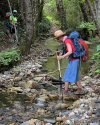

Last edited:
- Time of past OR future Camino
- Past: a few
Last: Sanabres
Next: St Olav's Way
Hmm! Looks more like a 90 degree angle to me. At 45 degrees, your hand would be almost level with your shoulder, and it isn't close to that.(I didn't slip in, thanks to the poles- looks like my elbows are at 45 degree angle here, anyway, it worked)
Ideal sleeping bag liner whether we want to add a thermal plus to our bag, or if we want to use it alone to sleep in shelters or hostels. Thanks to its mummy shape, it adapts perfectly to our body.
€46,-
€46,-
- Time of past OR future Camino
- 2018 (CF); 2022 (Via Tolosana -part)
Of course! You're right, wasn't thinking. And I think 90 degree angle is generally correct answer for me, having looked at other photos.Hmm! Looks more like a 90 degree angle to me. At 45 degrees, your hand would be almost level with your shoulder, and it isn't close to that.
* I have edited my initial reply to 90 degrees*
Most read last week in this forum
Hello!
I am following the instructions about editing my ACCOUNT DETAILS since I want to change the year of my past/present Camino/s but when I go to this page, the Past/Present Camino/s option is...
Is it possible to private message other members? I have tried clicking on the name of the person I’d like to message (a mod, to ask when the monthly start date threads are posted) but all I see is...
Similar threads
❓How to ask a question
How to post a new question on the Camino Forum.
Similar threads
Most downloaded Resources
-
“All” Albergues on the Camino Frances in one pdf“All” Albergues on the Camino Frances in one pdf
- ivar
- Updated:
-
A selection of favorite albergues on the Camino FrancésFavorite Albergues along the Camino Frances
- Ton van Tilburg
- Updated:
-
Profile maps of all 34 stages of the Camino FrancesProfile maps of all 34 stages of the Camino Frances
- ivar
- Updated:





